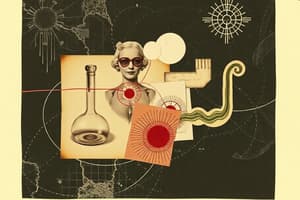Podcast
Questions and Answers
SU-8 resist layer thickness above 10 µm were not possible in the past.
SU-8 resist layer thickness above 10 µm were not possible in the past.
False (B)
Soft lithography with PDMS involves the transfer of stamp structures to surfaces by etching.
Soft lithography with PDMS involves the transfer of stamp structures to surfaces by etching.
False (B)
One of the drawbacks of SU-8 is its resistance to chemicals.
One of the drawbacks of SU-8 is its resistance to chemicals.
False (B)
PDMS is known for its toxic properties.
PDMS is known for its toxic properties.
In soft lithography with PDMS, the general principle involves the manufacturing of rigid PDMS stamps.
In soft lithography with PDMS, the general principle involves the manufacturing of rigid PDMS stamps.
Cross-linking of epoxy groups during PEB in SU-8 photoresist occurs below the glass temperature.
Cross-linking of epoxy groups during PEB in SU-8 photoresist occurs below the glass temperature.
SU-8 is commonly used in molding technology with soft silicone PDMS.
SU-8 is commonly used in molding technology with soft silicone PDMS.
The softbake step involves heating the substrate at high temperatures to ensure uniformity of the SU-8 layer.
The softbake step involves heating the substrate at high temperatures to ensure uniformity of the SU-8 layer.
The alignment process is not crucial when transferring the desired pattern onto SU-8 coated substrate.
The alignment process is not crucial when transferring the desired pattern onto SU-8 coated substrate.
SU-8 is resistant to most solvents, making it ideal for applications where chemical stability is crucial.
SU-8 is resistant to most solvents, making it ideal for applications where chemical stability is crucial.
PDMS stands for Poly-Dimethylsilicone and is a bonding technology used in microfluidic chips.
PDMS stands for Poly-Dimethylsilicone and is a bonding technology used in microfluidic chips.
SU-8 has no drawbacks and is considered a perfect photoresist material for microfluidic chip fabrication.
SU-8 has no drawbacks and is considered a perfect photoresist material for microfluidic chip fabrication.
During the post-exposure bake (PEB) step, the exposed SU-8 is further cured at a lower temperature.
During the post-exposure bake (PEB) step, the exposed SU-8 is further cured at a lower temperature.
The developer solution used to dissolve unexposed SU-8 is typically an aqueous solution.
The developer solution used to dissolve unexposed SU-8 is typically an aqueous solution.
In positive photoresist like AZ-Novolack, the exposed areas are cross-linked during the PEB.
In positive photoresist like AZ-Novolack, the exposed areas are cross-linked during the PEB.
SU-8 is advantageous in microfabrication due to its low resolution capabilities.
SU-8 is advantageous in microfabrication due to its low resolution capabilities.
One of the drawbacks of SU-8 as a photoresist is its poor adhesion to substrates.
One of the drawbacks of SU-8 as a photoresist is its poor adhesion to substrates.
Soft lithography with PDMS can be used for bonding technologies in microfabrication processes.
Soft lithography with PDMS can be used for bonding technologies in microfabrication processes.
Study Notes
SU-8 and PDMS Overview
- SU-8 resist layer thickness exceeding 10 µm was previously unachievable.
- PDMS (Poly-Dimethylsilicone) is integral in soft lithography for microfluidic chip fabrication.
- SU-8, favored for chemical stability, is resistant to most solvents, making it ideal for demanding applications.
Characteristics of SU-8
- Cross-linking of epoxy groups in SU-8 occurs below glass transition temperature during post-exposure bake (PEB).
- Softbake step involves heating the substrate to ensure uniform SU-8 layer thickness.
- SU-8 is commonly used in molding technologies, especially with soft silicone PDMS.
- Poor adhesion to substrates is a notable drawback of SU-8.
PDMS in Soft Lithography
- Soft lithography involves transferring stamp structures to surfaces via etching using rigid PDMS stamps.
- PDMS has toxic properties which may limit its applications.
- The alignment process for transferring patterns onto SU-8-coated surfaces is generally not critical.
Development Process
- Developer solution for SU-8 typically consists of an aqueous solution for dissolving unexposed areas.
- Unlike positive photoresists like AZ-Novolack, which cross-link exposed areas during PEB, SU-8 benefits from its curing process post-exposure.
Advantages and Disadvantages
- Despite some drawbacks, SU-8 is often regarded as a nearly perfect photoresist for microfluidic chip fabrication.
- SU-8’s resistance to chemicals and solvents is a key advantage for microfabrication applications, although its adhesion limits usability.
Studying That Suits You
Use AI to generate personalized quizzes and flashcards to suit your learning preferences.
Related Documents
Description
Test your knowledge on the process technologies used for microfluidic chips, including lithography with SU-8, molding technology with PDMS, and glass etching methods. Learn about substrate cleaning and prebaking techniques for microfluidic chip fabrication.




